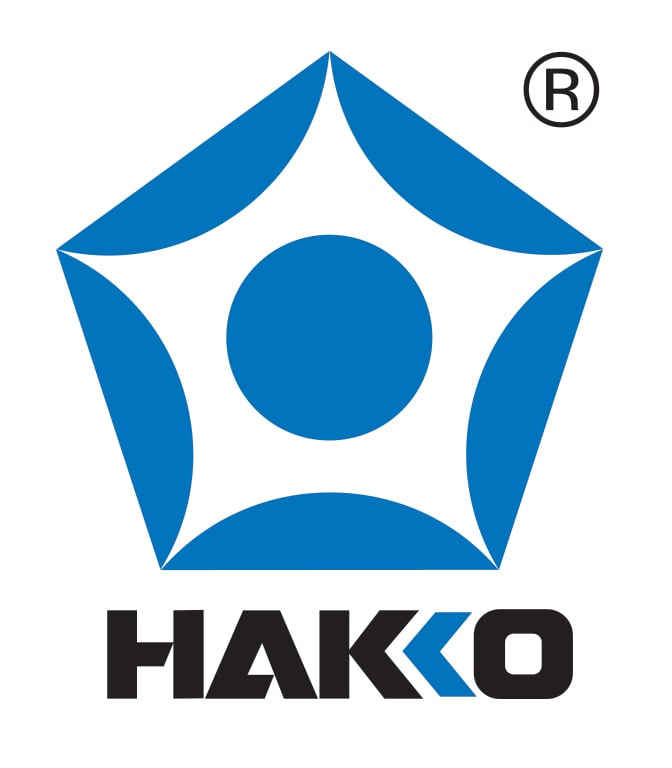|
(1) What is the difference between Lead-Free solder and regular tin-lead solder?
Lead-Free solders contain no lead and melt at a higher temperature than the popularly used 63Sn37Pb solder (63% tin, 37% lead) and 60Sn40Pb solder (60% tin, 40% lead).
Some of the most commonly used Lead-Free solder alloys are:
Sn-Ag (tin and silver; ~98-96% tin content)
Sn-Cu (tin and copper; ~96% tin content)
Sn-Ag-Cu (tin, silver, and copper; ~93-96% tin content)
Sn-Ag-Bi (tin, silver, bismuth; ~90.5-94% tin content)
Sn-Ag-Bi-Cu (tin, silver, bismuth and copper; ~90-94% tin content)
63Sn37Pb melts at 361°F (183°C) and solidifies at 361°F (183°C).
Note: Sn63 solder has no plastic range (the temperature range between the liquidus and solidus state.) Sn63 solidifies nearly instantaneously.
60Sn40Pb melts at 374°F (191°C) and solidifies at 361°F (183°C).
Note: Sn60 solder has a 13° plastic range (the temperature needed to cool down before reaching a solidus state.)
LEAD-FREE solders melting point ranges from 423°F (217°C) to 439°F (226°C).
To learn more about the Differences between tin-lead and Lead-Free solders CLICK HERE
For a brief Overview of Lead-Free solder use CLICK HERE
For a video demonstration of Sn-Pb vs Pb-Free solder CLICK HERE
(2) What can I expect when soldering Lead-Free solders? What problems may I encounter? Do I need to retrain my operators?
Some of the problems with lead-free soldering are:
- a higher melting temperature may damage components, including plastic connectors, relays, LEDs, electrolytic capacitors, and multilayer ceramic capacitors
- a higher temperature can cause PCB warping, which can crack multilayer ceramic capacitors (a common failure)
- a higher melting temperature may cause thermal shock to a component
- a higher melting temperature can cause plastics to melt or deform
- higher soldering temperatures result in poor solder spread-ability and wettability due to an increase in surface oxidation
- the need to use more active (and corrosive) fluxes
- the time required to form a good joint may be significantly longer than with a tin-lead solder
- PCB warping
- bridging or insufficient solder
- solder joints can be difficult to rework
- more solder balls
- flux spattering
- shorter tip life
- dull finish solder joint (not shiny)
- operator acceptance, frustration and willingness to change their style of soldering
To prevent thermal shock to the component:
- use the same soldering temperature as you would with a tin-lead solder
control the tip temperature
- use a soldering iron with great thermal recovery - the lower the soldering temperature and the larger the tip, the less heat loss
- use a high power soldering iron
- use the largest tip commensurate with the size of the joint being soldered
To help operator acceptance, reduce frustration, and improve performance:
Retraining is not necessary, but the following points should be addressed and understood by the operators before implementing a Lead-Free process:
- Unlike Sn60 and Sn63 solders, Lead-Free solders are UNFORGIVING. Therefore, it is imperative to keep the soldering iron TIPS CLEAN - and this means IMMACULATE.
Operators must accept the fact that soldering with Lead-Free solders will require them to adjust their style of soldering. This will require them to clean the tip constantly and understand that the time it takes to make the soldered connection may take longer than what they were used to when using Sn60 or Sn63 solder.
- IMPORTANT: Although Lead-Free solder melts at a higher temperature, this does not mean you need to turn up the temperature of your soldering iron. See question #3 below.
(3) Since Lead-Free solders melt at higher temperatures, do I need to increase the temperature of my Hakko soldering iron?
Not necessarily. By elevating the soldering iron temperature you may be making it more difficult to solder. The higher temperatures cause oxidation to form faster, thus making wetting even more difficult. Flux selection can help alleviate this situation somewhat, but we are still trying to live in a no-clean world.
Most no-clean fluxes have a very narrow process window. The activators are quickly consumed, presumably leaving no corrosive residues after soldering. The problem is no-lead solders need a longer process window, otherwise the flux is gone before the wetting process has been completed. This causes more touch-up.
The best answer is to select a soldering station what has excellent thermal recovery. This will allow you to solder lead-free solders without a large increase in tip temperature.
(4) How do I desolder with Lead-Free solder?
There is no special, magical process to desoldering Lead-Free solder. The only difference between desoldering a Lead-Free and a tin-lead soldered connection is that you may need to spend a little longer time desoldering the No Lead connection. Note: You do not necessarily need to increase the temperature of the desoldering tool though.
When desoldering a No Lead soldered connection, try to use the same desoldering temperature you would normally use to desolder a typical Sn63 or Sn60 soldered connection, because a higher temperature will result in faster oxidation of the desoldering nozzle/tip.
On the other hand, if a vacuum desoldering tool is used, higher temperatures must be maintained not only through the nozzle and heating element, but also right up to the entrance to the filter, lest the solder solidify and plug the tool before it is fully extracted. The Hakko FM-2024 desoldering tool is specifically designed for this function.
For more information about Desoldering Lead-Free alloys, CLICK HERE
(5) Is my new Hakko FM-2024 desoldering tool compatible with Lead-Free solder?
Yes. The FM-2024 desoldering tool will desolder lead-free solder. The Hakko N1 (FM-2024) nozzles are ideal for lead-free applications.

The N1 nozzles are shorter and designed with a wider throat to allow more solder intake, thus nearly eliminating clogging altogether.
Keep in mind, higher temperatures must be maintained not only through the nozzle and heating element, but also right up to the entrance to the filter.
For an FM-2024 desoldering video demonstration, CLICK HERE
(6) How do I desolder Lead-Free solder with the Hakko FM-2024 desoldering tool?
Select the proper nozzle and temperature for the soldered connection that will allow the connection to reflow in about 1-2 seconds.
Place the nozzle over the component lead and allow the solder to reflow (you may wiggle the nozzle slightly to uniformly transfer the heat throughout the connection.) As soon as the soldered connection has reflowed (typically in 1-3 seconds)
Press the trigger on the FM-2024 handpiece to start the vacuum. The solder will be immediately sucked into the disposable filter. When the filter is full, remove and discard. Replace with new filter.
(7) Will Nitrogen help me hand solder with Lead-Free solder?
Yes, but there are a few considerations that must be taken into account. Soldering irons are available with nitrogen attachments that flow nitrogen over the tip and connection area. The idea is, because nitrogen is heavier than oxygen, it will "push" the oxygen away from the termination area. This will help the solder wet and spread to the termination area, and the soldered joints will be bright and shiny. Also, using a soldering iron that emits nitrogen gas has the effect of preheating the component and termination area with high-temperature gas. In theory this works perfectly - less or no oxygen will result in less or no oxidation - but this is not a perfect world. In practical applications, you must have a constant source of nitrogen.
The graph below shows the difference between the tip temperature measured when using nitrogen gas and when NOT using nitrogen gas. To obtain the same temperature at the termination area (soldering point), the temperature setting of the tip can be lowered when using nitrogen gas.

Some facilities have nitrogen bottles or tanks and a complete plumbing system designed to deliver the nitrogen to any work bench. For those facilities that do not have a nitrogen delivery system, you must consider moving bottles or tanks around, or purchasing a nitrogen generating system (oxygen scrubber), which essentially filters (removes) the oxygen from the air.
A nitrogen iron will require an attachment. This will increase the diameter of the tip, and usually the iron itself. Depending on the type of soldering you will do, this may cause additional issues and/or operator discomfort.
N2 SOLDERING SYSTEM
The Hakko FX-780 Nitrogen Generator, FX-781 Controller and FM-2026 iron is an efficient nitrogen soldering system. It can be used with the Hakko FM-202 and FP-102 soldering stations. For detailed information on the system, click on the image below.

Hakko N2 Soldering System
Does nitrogen improve wetting?
Yes, nitrogen will improve wettability and spread-ability, and it will inhibit oxidation.
Is nitrogen worth the extra expense and hassle?
Maybe. Cost justification and implementation will depend on the soldering application, the product you are soldering, and your plant/production line layout.
For more information about N2 soldering, CLICK HERE
(8) My tips do not last as long with Lead-Free solder. Why?
Most lead-free alloys proposed or on the market today are very tin-rich, therefore you must be careful to monitor tip corrosion and erosion.

Soldering tips usually consist of a copper core, plated with iron and flashed with chromium. Tin forms intermetallic compounds with iron, for both are relatively active metals, and chemical reactions are more active at high temperatures. (Most active fluxes at high temperatures serve to exacerbate this condition.)
For a brief overview of Fluxes with Lead-Free soldering, CLICK HERE

Figure 1. Comparison of Intermetallic Compounds for Different Solders
As shown in Figure 1, the intermetallic compound is virtually non-existent in 63Sn37Pb solder (Photo A), whereas, a large amount of intermetallic compound (15 µm) is formed in the Lead-Free Sn-3.7Ag-0.7Cu solder (Photo B),
The speed at which the intermetallic compound of tin and iron is formed varies depending on the temperature. As the temperature becomes higher, the erosion rate of the tip increases, especially at temperatures of 400°C or more.

Figure 2
Cross-section of a New Tip

Figure 3
Cross-section of a Tip with Failed Plating
Every time you make a solder joint, tin reacts with the iron, gradually eroding the iron away until the tin breaks through the iron plating. Once the iron/chromium is abraded or cracked, tin reacts with the copper (dissolves it) and destroys the tip (Figure 3).

Figure 4
Comparison of Solder Composition and Erosion Rate
The rate of tip erosion varies with different solder alloy compositions. As shown in Figure 4, Sn-0.7Cu (tin/copper) erodes the tip faster than Sn-3.5Ag-0.75Cu (tin/silver/copper), which erodes faster than Sn-3.5Ag (tin/silver) solder, which erodes faster than Sn-37Pb (tin/lead), etc.
Compared to lead eutectic solders (ie. Sn-37Pb), Lead-Free Sn-3.5Ag-0.7Cu (tin/silver/copper) solder erodes approximately 3X faster and the Lead-Free Sn-0.7Cu (tin/copper) solder erodes approximately 4X faster when the tip temperature is 400°C.
In addition to corrosion, oxidation is also a problem (see Question 16 below)
For more information about Soldering with Lead-Free alloys, CLICK HERE
(9) How can I extend the tip life?
The following simple steps will help increase the longevity of your tips:
- USE the lowest possible soldering temperature (360°C or less)
- CLEAN the tip during use with a good tip cleaner (ie. Hakko 599B) and often
- APPLY new solder to the tip before placing the iron back into the holder
- TURN OFF the iron when not in use for 10 minutes or longer

Hakko 599B Tip Cleaner
The Hakko 599B cleans the soldering iron tip without using water. The coiled wires are impregnated with flux, which can eliminate oxide from the tip surface and prevent the surface from being oxidized by leaving a solder film on it. In addition, since water is not used, the tip is cleaned without lowering the tip temperature.
(10) Is the Hakko 485 Soldering System Lead-Free compatible?
Yes. The impeller and chamber are treated with a special coating to resist the corrosive effects of high temperature solders.
(11) Is my Hakko 96 soldering pot Lead-Free compatible?
Due to the high tin content of lead free solders, the Hakko 96 solder pot requires an optional special coating to extend the solder pot life. Although you can use lead-free alloys with the 96 solder pot, we do not recommend it because the pot does not contain this special coating, and without it the pot life will be shortened. That said, we recommend you use the new Hakko FX-301B digital soldering pot (shown below.)

The Hakko FX-301B digital soldering pot is specially designed for Lead-Free alloys. The unit has four separate programs specifically designed for either SnPb, SnAgCu, SnCu, or Sn100 alloys.
For more information, CLICK HERE
(12) Can I use my Hakko 191 thermometer and 192 soldering tester with Lead-Free solder?
 Yes. However, if you experience short sensor life, you may want to change to the 191-212 sensors. Yes. However, if you experience short sensor life, you may want to change to the 191-212 sensors.
The Hakko 191-212 sensor wire is not pre-tinned and the pad is not welded but crimped. The sensor wire is lead-free. Depending on the composition of the lead-free solder, the standard 191-211 sensor may be acceptable.
(13) I've noticed a difference in performance and life-span between different brands of tips when using No Lead solder. Why do Hakko tips last longer and work better than other brands?
Hakko tips are plated with a thick iron (Fe) plating; this, combined with the excellent thermal recovery of the Hakko irons/stations, provides a longer tip life and greater performance.
QUIZ: Below are two different tip styles. Which one has the greater thermal recovery performance, Type A or B?

The answer is Type B. Type B has greater thermal capacity and higher thermal conductivity than Type A due to the larger (copper) mass of the tip. Even though the shape of the point of each tip is the same, the mass of Type B is greater. The tip with a larger (copper) mass will always maintain its temperature better (see graph below.)

(14) When will I need to start manufacturing Lead Free products at my facility?
RoHS is the European Parliament Directive entitled, "Restrictions on the use Of Hazardous Substances." RoHS prohibits the use of lead (Pb), cadmium (Cd), mercury (Hg), hexavalent chromium (Cr(VI)), polybrominated biphenyls (PBBs) and polybrominated diphenyl ethers (PBDEs) in electrical/electronic equipment.
U.S. electronic manufacturers who supply electrical/electronic equipment for European countries must be RoHS compliant after July 1, 2006. This means finished product. You will need to implement a lead-free process into your production schedule accordingly to meet the July 1, 2006 delivery date for European countries.
Note: There are exceptions to RoHS. These exceptions include: lead in the glass of cathode ray tubes, lead in high-melt solders, lead in solders for servers, storage and storage array systems, and lead in solders for network infrastructure equipment for switching, signaling, transmission, as well as network management for telecommunications.
(15) Are Hakko Tips Lead-Free compatible?
YES. The Hakko soldering iron tips and desoldering nozzles are tinned with lead-free solder. Please click on the link below for a thorough understanding.
For detailed information, CLICK HERE
(16) Solder will not wet to the soldering iron tip surface. Why?
Oxidation. This is caused by the oxidation of the intermetallic compounds generated between tin and iron. Chances are, the tip was exposed to a high temperature for a long time. Turn the iron off when not in use for a length of time.

Is the tip covered with carbonized flux (carbide and burned flux residue are stuck to the iron base)? If so, the tip cannot transmit sufficient heat to the soldering connection. The soldering tip transmits heat to the soldering connection by using the solder retained on the tip as a medium of heat. If the tip is covered with carbonized flux, one or more of the following has occurred: The iron base of the tip is exposed and oxidized, and the intermetallic compound of tin and iron is oxidized. These phenomena occur at high temperatures. Turn the iron temperature down.
Poor or defective plating will cause the oxidation of plating impurities. Use a tip with high quality plating.
NOTE: If wettability cannot be recovered due to oxidation and blackening, even when solder is fed to the tip, you can rejuvenate the tip to new life using the Hakko FT-700 tip polisher (see #17 below.)
(17) The higher temperatures typically required for Lead-Free soldering combined with the highly-active fluxes is killing my soldering iron tips.
I know there is still plenty of (plating) life in them but the oxidation and corrosion are making them useless.
Is there a way I can safely bring new life back to my tips?
YES. The Hakko FT-700 tip polisher is specially designed to rejuvenate your soldering iron tips back to life.
The FT-700 is a FAST and EASY way to remove heavy oxide and corrosion from your soldering iron tip. Simply dip your (hot) tip into the special, lead-free petrolatum paste then insert it between the two spinning brushes. This will clean the tip and remove the oxides. (Don't forget to tin the tip afterwards with the solder you are currently using before returning it to the holder.)
For complete details of the FT-700 tip polisher CLICK HERE.
(18) I see Hakko offers a variety of cleaning products and methods. Which ones work best when soldering with Lead-Free solders?
The best benchtop setup would be to incorporate them into a systematic method or process. As we have said, tip maintenance is the key to increasing the longevity of your soldering iron tips when working with lead-free alloys. Always, always, always clean the tip after every use. Hakko offers four (4) tip cleaning methods (see below) which can be used individually or combined into a systematic process to insure best results.
1. wipe the tip across a wet sponge (P/N: A1495)
2. or, poke the tip into the Hakko 599B dry tip cleaner
3. or, dip the tip into the lead-free FS-100 chemical paste, then poke the tip into the 599B (#2) to remove the paste and tip oxidation
4. or, dip the tip into the lead-free FS-100 chemical paste (#3) then insert the tip between the spinning brushes of the Hakko FT-700 tip polisher
No other soldering iron manufacturer offers such a comprehensive variety of tip cleaning methods which are specifically designed for lead-free soldering.
(19) Is the Hakko FS-100 chemical paste safe to use?
YES. The Hakko FS-100 chemical paste does NOT contain diammonium phosphate, which is a byproduct of ammonia and phosphoric acid found in other brands. The paste will not harm the tip and the printed circuit board will not corrode due to flux residue (paste conforms to JIS-Z-3197 6.6.1 test method.)
For enhanced effectiveness, use the FS-100 chemical paste in combination with the Hakko FT-700 tip polisher.
(20) Will the Hakko HJ3100 extract lead fumes?
There is not, and never has been, a need to extract 'lead fumes' from the air while soldering. The smoke is a by-product of partial combustion of the soldering flux. No more. No less. Lead does not vaporize at soldering temperatures.
For more information about Fume Extraction and Lead-Free soldering, CLICK HERE
(21) Can I rework a Lead-Free board with hot air?
Yes, but keep in mind, hot air soldering with Lead-Free alloys may require a higher air temperature, which could cause damage to the components' plastic packages, induce board warping, and lead to problems with the solderable finish. Thus, the melting point of a Lead-Free alloy is important to know, as many components and materials cannot withstand the very high peak temperature (>260°C) of some tin-silver and tin-copper alloys.
For more information about Hot Air rework, CLICK HERE
(22) Why is there so much solder and flux spattering with Lead-Free solder?
Flux spattering is related to the composition of the flux used. Lead-Free solders typically use a very active flux in an effort to improve wetting. These highly aggressive fluxes react to high temperatures like drops of cold water on a hot skillet. The flux in the cored-solder abruptly expands and burst through the solder. This phenomena can also occur with rosin-based fluxes but typically only at high temperatures, and not necessarily with all rosin fluxes (activators and chemical formulations vary between flux manufacturers.) Regardless of the flux you use, as a general rule, the higher the temperature, the more spatter you can expect.

Hakko 375 V-Groove Solder Feeder

Hakko has addressed this problem with the "375" V-groove solder feeder. The "375" cuts a v-shaped groove in the flux-cored solder, preventing the flux from expanding in the solder and bursting. This innovative process has shown to reduce solder and flux spatter, while improving solder spread-ability at the same time (see graph below.)

Note: The Hakko "375" is not available in North America at this time.
(23) How does the Hakko 936 soldering station compare to the FM-202 station when soldering Lead-Free solder?
The Hakko FM-202 (FM-2021 iron) has an integrated heater, sensor and tip. It is smaller and provides higher thermal recovery performance than conventional soldering irons (ie. 907 and 908 irons used with the 936 soldering station). To illustrate this fact, the thermal recovery performance of the FM-2021 (FM-202 station) and the 907 and 908 irons (936 station) were compared.
A sensor was attached to soldering points 1, 4, and 7 on a PCB (see photo below), then the seven points on the board were soldered in succession (using the FM-2021, 907 and 908 irons) at three (3) second intervals. Simultaneously, the temperature changes of the soldering points and the soldering tip were measured.


Figure 5
Figure 5 illustrates the FM-2021 has the highest soldering point temperature, which remains constant even under continuous soldering. On the other hand, the temperature drop of the "907" compared to the "908" was significant. The "908" has a larger thermal capacity than the "907."
The soldering point temperature varies depending on the area to be soldered. Some areas can be soldered satisfactorily with the "907" if the temperature drop at the soldering point is small. But as Figure 5 illustrates, the FM-202 (FM-2021 iron) clearly has the best thermal recovery.
(24) I have been told that the smoke and fumes from soldering Lead-Free flux-cored wire solders is more dangerous than tin-lead solders. Is this true?
Breathing any flux fumes, whether from a Lead-Free solder or tin-lead solder is not in the best interest to your respiratory health and should be avoided. Although a more aggressive (acidic) flux is a popular method used by solder manufacturers to help increase the wetting of their Lead-Free alloys, in many cases the flux in their Lead-Free solder is the same as that in some of their tin-lead solder. Regardless, whether you are soldering with a Lead-Free solder or a tin-lead solder, a highly efficient smoke and fume extraction system should be used.
Breathe Easy. For a highly-efficient smoke and fume extraction system, the Hakko FA-430 is the best fume extraction system for your buck.

The FA-430 is a high-mass flow, low-vacuum system that utilizes a three-stage filtering process that includes (1) a pre-filter to remove coarse particles as small as 30 microns in diameter (2) a HEPA (High Efficiency Particulate Air) filter that consists of a pleated fiberglass paper medium, providing the greatest amount of surface area within the volume of the filter case, and (3) an activated carbon filter that is built into the HEPA filter, which is designed to last the life of the HEPA.
 Use the FA-430 with the Loc-Line flexible duct systems and those unhealthy smoke and fumes are removed directly at the source. The flexible segmented hoses are capped with either a round or rectangular nozzle/hood and can be placed close to the work area, and moved out of the way when needed. The systems are ESD safe, too. Use the FA-430 with the Loc-Line flexible duct systems and those unhealthy smoke and fumes are removed directly at the source. The flexible segmented hoses are capped with either a round or rectangular nozzle/hood and can be placed close to the work area, and moved out of the way when needed. The systems are ESD safe, too.

For more information, CLICK HERE
(25) What financial $$$ impact can we expect when we switch from a tin-lead to a Lead-Free process?
You can expect your assembly production costs to increase, and in some areas, dramatically. Pb-Free solder is not cheap. Compared to tin-lead, Pb-Free solder is very expensive. Then you will need to use Pb-Free compatible boards, components, and perhaps invest in new Pb-Free compatible equipment (ie. reflow ovens, nitrogen systems, vapor phase systems, wave soldering systems/pots, etc.). The list goes on.
For many years now, purchasing agents have been accustomed to lower merchandising cost year after year. This mindset will need to change with Pb-Free. Environmental-friendly manufacturing comes with a price.
WAVE SOLDERING
Wave soldering will be impacted the most. Sn-Ag-Cu (tin-silver-copper) and Sn-Cu (tin-copper) alloys are two common Lead-Free solders used. Copper dissolution into Lead-Free alloys will require more solder pot maintenance.
Sn-Pb (tin-lead) solder intermetallics float and can be easily removed. Sn-Cu (tin-copper) intermetallics on the other hand, sink and are dispersed through the Lead-Free alloy in the pot, causing the pot's wave baffles to exhibit a sluggish flow. This copper build-up in the pot will require the pot to be dumped and replenished more often. Waste and replenishing costs can be high, particularly if you do a lot of wave soldering.
To compound the above scenario, as Lead-Free assemblies increase, more and more copper boards will probably be used. This will result in even more copper dissolution into the solder pot.
Then there is the increased process temperatures needed for Lead-Free alloys, which will require more energy. Some facilities may see their energy usage increase as much as 25%.
HAND SOLDERING
Hand soldering costs will also increase. As explained in questions 2, 8, 9, and 13 above, the life-span of your soldering iron tips will be shorter than when you were soldering with tin-lead solder.
Hakko has addressed this issue by manufacturing Pb-Free tips with a thick iron (Fe) plating. This, combined with the excellent thermal efficiency and recovery of the Hakko irons/stations, helps prevent the need to increase the soldering iron temperature, while providing greater performance and a longer tip life than many competitor brands. But do not expect any tip to last as long as it once did when you were soldering with a tin-lead solder.
You can help increase the life of your soldering iron tip yourself by simply keeping the tip CLEAN. This will help reduce your tip cost. Of course, keeping the tip clean is something only the operator can control. (See question #1 above)
(26) Is there a Hakko hot air unit available that is certified for the higher temperatures for lead free rework?
With Pb-free solder you will be soldering at a temperature very close to what you used with the Sn/Pb solders. In most cases the melting point of the solder is only 40-50ºF higher. Soldering at higher temperatures will greatly increase the amount of oxidation and will quickly consume all the flux, making it more difficult to solder Pb-free solders. Keep your soldering temperature close to what you used with Sn/Pb solders and you should be able to make reliable solder connections. The 850 series (850D, 852) can reach temperatures of 840ºF, which is hotter than you will be required to solder Pb-free solders.
Thank you for visiting our Lead-Free section.
"Fresh air impoverishes the doctor." — Danish Proverb
|
